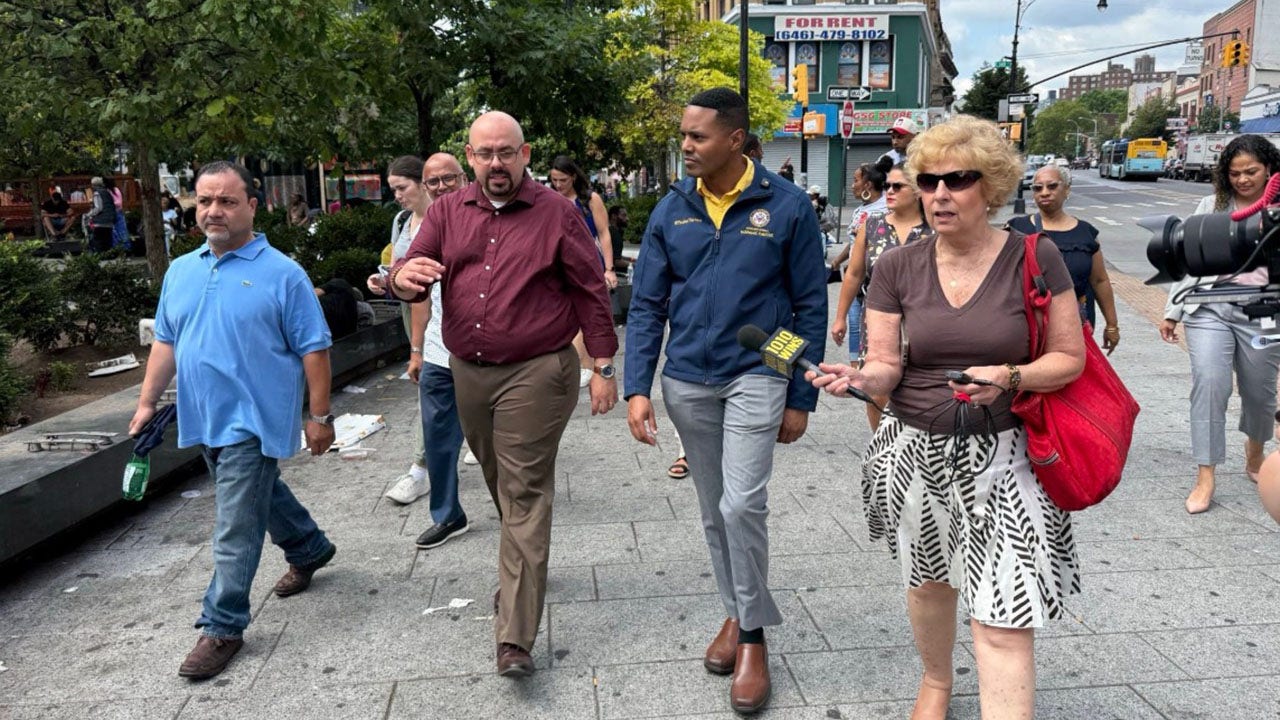PROTECT YOUR DNA WITH QUANTUM TECHNOLOGY
Orgo-Life the new way to the future Advertising by AdpathwayFor decades, El Salvador was a country that people fled — escaping gang violence, poverty, natural disasters and civil wars. But that trend is shifting.
Migration from El Salvador to the United States — the main destination for Salvadoran exiles — has dropped sharply in recent years. And now, a small but growing number of Salvadoran emigrants are returning home voluntarily, encouraged by new infrastructure, lower living costs and one of the most dramatic public security overhauls in the region.
 The Salvadoran Congress building is seen from the air in San Salvador, El Salvador, Feb. 9, 2020.Salvador Melendez/AP/File photo
The Salvadoran Congress building is seen from the air in San Salvador, El Salvador, Feb. 9, 2020.Salvador Melendez/AP/File photoDowntown San Salvador is barely recognizable to those who knew it in the 2000s. Just a few years ago, the area was fractured by gang territories, a place where invisible lines marked danger zones. Now, it’s filled with tourists, food vendors and local families.
“Walking here was terrifying,” said Vanesa Carmina, standing near the Cathedral Plaza. “Residents wouldn’t come here at all. But now we can go out without fear.”
A massive new National Library — six floors of glass, concrete and open space — sits in the center of the plaza, open 24 hours and brimming with modern technology. It’s part of President Nayib Bukele’s sweeping campaign to remake the image of El Salvador and reclaim public space once ceded to gangs.
 Pedestrians walk past the new National Library, donated by the People’s Republic of China, in the historic center of San Salvador, El Salvador, Jan. 24, 2024.Salvador Melendez/AP/File photo
Pedestrians walk past the new National Library, donated by the People’s Republic of China, in the historic center of San Salvador, El Salvador, Jan. 24, 2024.Salvador Melendez/AP/File photoBukele launched a nationwide crackdown on gang violence in March 2022 after a deadly surge in homicides. Since then, authorities have arrested more than 78,000 people, often under emergency powers that suspend basic civil liberties.
The homicide rate has plunged, and the country has gone from one of the most dangerous in the world to one of the safest in the Western hemisphere.
 Ervin Rivera, a sixth grade Salvadoran immigrant, reads his story to teacher Alison DeFaclo. A group of youth wrote a book about how they fled street gangs in Central America in search of a better life in a New York town plagued by the same gang violence, June 14, 2017.Michael Noble Jr./AP/File photo
Ervin Rivera, a sixth grade Salvadoran immigrant, reads his story to teacher Alison DeFaclo. A group of youth wrote a book about how they fled street gangs in Central America in search of a better life in a New York town plagued by the same gang violence, June 14, 2017.Michael Noble Jr./AP/File photoFor 52-year-old Orsi Chicas, that shift was enough to leave behind a life in California and return home. After two decades working in hospitality and construction, Chicas is now building a small real estate business with savings from the US.
“My country is beautiful and totally safe,” he said. “The US is good for working, but it’s hard, physical labor, and not everyone is made for that.”
Chicas is one of a small but visible group responding to El Salvador’s new “Reverse Migration” policy. The government now offers returning migrants tax breaks, duty-free imports and reduced customs barriers. A new law passed in 2023 aims to streamline the repatriation process and encourage investment from abroad.
Others are coming back because the math simply works. José Vidal returned to El Salvador after 30 years in Los Angeles. “My US pension wasn’t enough to live on in California,” he said. “But here in San Salvador, I can get by comfortably.”
The number of Salvadorans returning home is still relatively small. Just over 15,000 people returned in 2024, according to the United Nations. That figure includes both deported individuals and voluntary returnees. But it represents only about 1% of all Salvadorans living in the US.
 José Palma, a 48-year-old Salvadoran who has lived in the US since 1998, stands in his home in Texas, Jan. 8, 2025.Lekan Oyekanmi/AP/File photo
José Palma, a 48-year-old Salvadoran who has lived in the US since 1998, stands in his home in Texas, Jan. 8, 2025.Lekan Oyekanmi/AP/File photoStill, the trend is notable, especially when paired with the drop in outward migration.
Migration from El Salvador began to fall in 2020 due to pandemic-related travel restrictions. But the slowdown continued even after the borders opened, and during the first years of President Biden’s term, when border apprehensions surged exponentially.
According to a joint survey by the International Organization for Migration and the Central Reserve Bank of El Salvador, about 60% of Salvadorans living in the US say they would like to return to their home country someday. But only around 6% are making concrete plans to do so in the near future.
Some are encouraged by success stories like those of Chicas and Vidal. According to Chicas, in his own circle of friends, nearly a dozen people are planning to return this year.
But many are not ready to make that leap, or are moving in the opposite direction.
Fleeing authoritarianism
Abel Nuñez, a Salvadoran immigrant in Washington, DC, said he has no plans to return to his native country. “I’ve spent more of my life in the US than in El Salvador. The US is now home for me,” he said.
Nuñez, an immigration activist, is also deeply concerned about El Salvador’s political direction. He believes the Bukele government is becoming increasingly authoritarian — replacing judges, controlling the legislature, approving unconstitutional re-elections and using the military to round up tens of thousands of people without due process.
 El Salvador’s President Nayib Bukele arrives at the National Theater to deliver his annual address to Congress in San Salvador, El Salvador, June 1, 2025.Salvador Melendez/AP
El Salvador’s President Nayib Bukele arrives at the National Theater to deliver his annual address to Congress in San Salvador, El Salvador, June 1, 2025.Salvador Melendez/AP“He’s making very authoritarian decisions,” Nuñez said of Bukele, who’s one of the most popular presidents in the world. “Democracy is more than just elections. It’s about rights, and those are being eroded.”
While Bukele’s government promotes a narrative of Salvadorans coming home to safety and opportunity, others are leaving the country because of fear and repression. That includes dozens of Salvadorans, including lawyers, academics, human rights defenders and journalists.
The Trump administration is backing Bukele’s government by funding detention programs for deported migrants and framing him as a model for regional security.
 The exterior of the Terrorist Confinement Center (CECOT) as Homeland Security Secretary Kristi Noem arrives, in Tecoluca, El Salvador, March 26, 2025.Alex Brandon/AP/File photo
The exterior of the Terrorist Confinement Center (CECOT) as Homeland Security Secretary Kristi Noem arrives, in Tecoluca, El Salvador, March 26, 2025.Alex Brandon/AP/File photoNuñez, who works in immigrant advocacy, said that fear is rising. He also notes that the US is becoming less welcoming to undocumented immigrants — more than 700,000 Salvadorans in the US remain without legal status.
“People used to flee to the US for refuge,” he said. “But now, repression is growing in El Salvador, and in the US, they no longer feel safe either.”
 CASA de Maryland holds a rally near the White House in Washington in reaction to an announcement regarding Temporary Protective Status for people from El Salvador, Jan. 8, 2018.Pablo Martinez Monsivais/AP/File photo
CASA de Maryland holds a rally near the White House in Washington in reaction to an announcement regarding Temporary Protective Status for people from El Salvador, Jan. 8, 2018.Pablo Martinez Monsivais/AP/File photoIn the end, return migration in El Salvador reflects a country at a crossroads — a place where safety has improved dramatically for some, while political freedoms have eroded for others.
For those who left long ago, the decision to come home is as personal as it is political.
And for many, the answer is still uncertain.
Julia Gavarrete contributed to this report.












 English (US) ·
English (US) ·  French (CA) ·
French (CA) ·  French (FR) ·
French (FR) ·